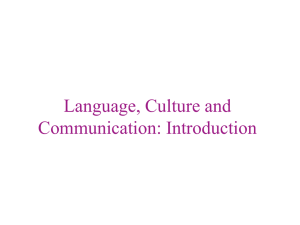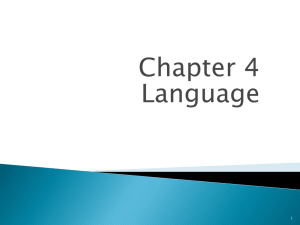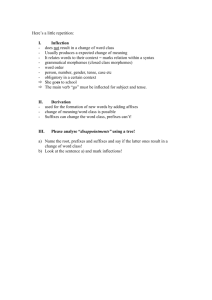Formal Properties of Language: Talk is achieved through the interdependent components of
advertisement
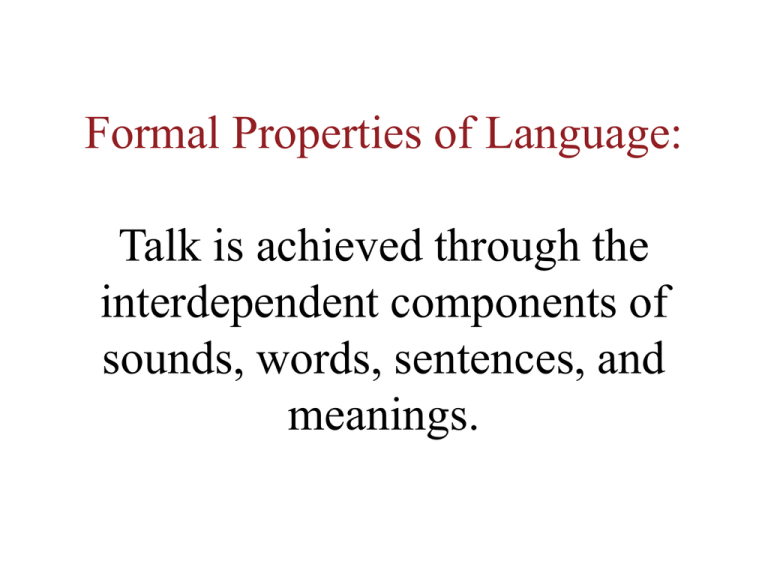
Formal Properties of Language: Talk is achieved through the interdependent components of sounds, words, sentences, and meanings. Last class we learned about: • the importance of language in human behaviour • the different meanings transmitted by language • cultural contexts and cultural models • speech community The components of language: • the sounds of language, • the structure of language • and the meanings of language What is Language? • Language is a communicative system consisting of formal units (of sound, structure, and meaning) that are integrated through processes of combination. Phonology: • the study of the distinctive, contrastive sounds (“phonemes”) of a language. • Phonetics and phonemics Phonetics • it is the study of the articulation of sounds that occur in a language • it describes how sounds are produced or articulated • it tries to describe how human language becomes possible through the manipulation of vocal apparatus. • Voiced/voiceless oral/nasal Phonemics • It analysis how sounds are used to differentiate meanings of words • It looks at how phonemes function to differentiate the meanings of words • contrasts signal differences in meanings of words • For example, in English /b/: pit versus bit Prosodic features • • • • • Stress Pitch Length Present and object They came in. They came in? Grammar • Morphology • Syntax Morphology • Is concerned with how phonemes are combined by language into larger units • Words: one or more morphemes Morphological Example • Cow-----Cow- boy • Affixes: bound morphemes: dis --- dis-like Syntax • rules that determine how words should be combined to make sense to speakers of a language • (English) word order critical for meaning (you, are, and there) There you are, You are there, Are you there? In Romance languages • Order of words not as • important Spanish: Ahi estas tu--Tu estas ahi • Tu estabas ahi • You were there Mandarin, Chinese • • • • • Meaning primarily determined by tone: Ma High= Mother Rising=horse Falling=scolding Exceptions to syntax rules Eat Ate eated Morphological Analysis • Morphology: the analysis of the structure of words • Morphemes=words • Cat or Cat-S • /P/ /I/ /N/ = PIN Roots (stems) and Affixes Roots: they have meaning in themselves cat,good, happy Affixes:Are attached to roots (express grammatical meanings) un-, -s, -ing, -ly Three kinds of affixes: Prefixes: un-happy suffixes: happy-ness and infixes: fikas: fumikas (Strong ---He is becoming strong) Morphological Typologies • Classification of languages according to how they structure words out of morphemes • Isolating languages: few morphemes, simple method: prefix and suffix (English) • Agglutinating languages: words containing many morphemes, highly regular rules (Turkish) • Synthetic or polysynthetic: Words containing many morphemes, very complex rules (Inuktitut) Qasirrsarrvigssarsingitluinarpug “someone did not find a completely suitable resting place” Grammatical meanings • Tense (time of the event’s occurrence) I visited the zoo • Aspect (manner in which an events occurs) I am visiting the zoo • Mode (likelihood of an event’s occurrence) I could visit the zoo Syntax • Is an analytical tool that linguists utilize to study the structure of sentences, including construction of phrases, clauses, and the order of words • Example • The dog chased the cat • The cat chased the dog Semantics • The study of meaning in language, including the analysis of meanings of words and sentences • Types of meanings produced by language: situational, social and cultural Language rules over regularalizations • Past tense of regular verbs (english)by adding ed as in worked • I gave • I took I gived I taked Linguistic interference • Idiomatic expressions • En este momento (literal translation) at this moment (Instead of now) • Drive down the parkway and park on the driveway. • Chop the tree down and cut the pieces up. • His nose is running and his feet smell.
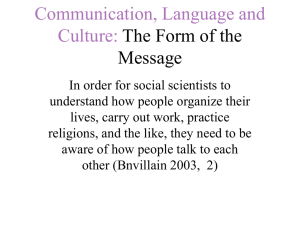
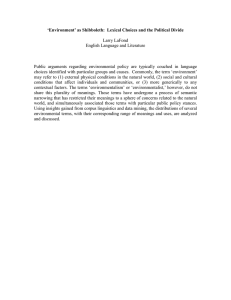
![Word Study [1 class hour]](http://s3.studylib.net/store/data/007905774_2-53b71d303720cf6608aea934a43e9f05-300x300.png)

